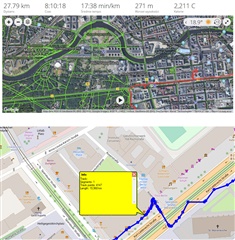Hello,
Last two days I had possibility to test Walk activity on longer distances. While walking I spent some time indoors, I'm pretty sure GPS didn't have enough sky to get satellites. In the end of the trip I get info from Instinct I walked almost 28km. I knew it wast totally not true. Today I exported GPX and opened it in OkMap. I believe this program measures distance in simplest possible way. Result is 16km which is much more reasonable. I wonder where from is this difference which gives all statistics from Garmin into trashbin. I know GPS had problem with signal but I would expect that software would be able to just measure length of track instead of giving totally crazy numbers.

I have to admit, with clear sky in the mountains I didn't experience this issue. But when I walk I don't always remember to pause recording and then run it again and probably it will affect overall time of walk?
What's funny: I had with me Huawei phone, second person had Samsung, both were recording steps only in automatic mode (without GPS) and result was almost identical: 13.5km.
In this case this simple measuring method was the most accurate.
Regards Rafal


